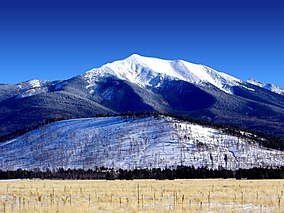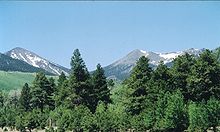Coconino National Forest
| Coconino National Forest | |
|---|---|
 San Francisco Peaks, winter | |
| Location | Coconino, Yavapai, and Gila counties, Arizona, US |
| Nearest city | Flagstaff, Arizona |
| Coordinates | 34°45′27″N 111°45′52″W / 34.75750°N 111.76444°W |
| Area | 1,856,038 acres (7,511.12 km2) |
| Established | July 2, 1908 |
| Visitors | roughly 1,890,000 (in 2004) |
| Governing body | U.S. Forest Service |
| Website | www.fs.usda.gov/coconino |
The Coconino National Forest is a 1.856-million acre (751,000 ha)
Etymology
Coconino is the word the
Geography
The elevation in the forest ranges from 2,600 feet (790 m) in the southern part of the forest near the

The northernmost district, known as the Flagstaff District, is home to the
Located in the southern portion of the Flagstaff District is Mormon Lake, the largest natural lake in the state of Arizona. Several other natural lakes, including Ashurst Lake and Marshall Lake, dot the top of Anderson Mesa, an approximately 20-mile (32 km) long ridge that rises 200 to 400 feet (60−120 m) above the surrounding landscape. Anderson Mesa is best known for the branch of Lowell Observatory located along the edge of the mesa. At the base of the southwest side of Anderson Mesa are two narrow, manmade reservoirs constructed in the early 1900s, Upper Lake Mary and Lower Lake Mary. Upper Lake Mary contains water year round in all but the very driest years while Lower Lake Mary, located just to the northwest of Upper Lake Mary, usually resembles a wet meadow rather than a lake.
The Red Rock district, centered on the town of
The Third district is the Mogollon Rim District, located along the Mogollon Rim south of the Mormon Lake District and east of the Red Rock District. The landscape here resembles the Mormon Lake District with a number of small lakes and perennial streams scattered among a dense ponderosa pine forest. The southern boundary of the district is the edge of the Mogollon Rim where the Coconino National Forest borders the Tonto National Forest and Coconino County borders Gila County.
Flora
Conifers and other evergreen plants are the dominant type of vegetation in the Coconino National Forest. Due in part to the dry climate, deciduous trees are rare except for in some moist areas along creeks and streams. While the ponderosa pine is by far the most common tree species in the Coconino National Forest, vegetation type varies depending on the elevation of a certain area.
At the lowest elevations, in the extreme southwestern portion of the forest, actual trees are scarce and the landscape is dominated by various small
The huge stands of
The highest elevations in the forest are located in the San Francisco Peaks area north of Flagstaff. Here grow large conifers such as
Above 11,000 feet (3,400 m) is found the only
Wildfire
Wildfire is a major concern across the Coconino National Forest. Despite the abundance of green vegetation throughout the forest, the region is classified as a high desert. Flagstaff, located in the northern part of the forest, receives about 22 inches (560 mm) of precipitation annually—including an average annual snowfall of 100 inches (250 cm)—while other areas of the forest receive even less.[5][9] The lack of any significant rainfall during the spring and early summer combined with the high temperatures and strong winds that are commonplace during that time of year results in fire danger that is usually defined as "very high" or "extreme" during the months of May through July. The danger of a major wildfire is increased by the fact that there are a number of cities and communities surrounded by forest land. Restrictions on campfires and smoking in the forest are common during peak fire season. Occasionally, the fire danger will become so great that the forest is closed to all public entry until substantial precipitation is received to minimize the danger of a stray spark setting off a destructive wildfire.
Over the past few years, the Coconino National Forest has increased its use of
Wilderness areas

There are ten federally designated
- Fossil Springs Wilderness
- Kachina Peaks Wilderness
- Kendrick Mountain Wilderness (mostly in Kaibab NF)
- Mazatzal Wilderness (mostly in Tonto NF)
- Munds Mountain Wilderness
- Red Rock-Secret Mountain Wilderness
- Strawberry Crater Wilderness
- Sycamore Canyon Wilderness (partly in Prescott NF and Kaibab NF)
- West Clear Creek Wilderness
- Wet Beaver Wilderness
History

When the United States acquired the territory comprising Arizona and New Mexico by treaty with
In 1898, President William McKinley established the San Francisco Mountain Forest Reserve, at the request of Gifford Pinchot, head of the US Division of Forestry. Local reaction was hostile—citizens of Williams, Arizona held a mass protest, and the Williams News editorialized that the reserve "virtually destroys Coconino County."[10]
In 1905, the Forest Reserves were transferred to the Department of Agriculture. Some 21 million acres (85,000 km2) of public lands, almost one-eighth of the area of Arizona and New Mexico, were now to be administered by the new Forest Service.
In 1908, the Coconino National Forest was established from parts of the
See also
References
- ^ "Historical Establishment Dates Pertaining to the Coconino National Forest". U.S. Forest Service, Coconino National Forest. Archived from the original on 2011-11-11. Retrieved 2006-08-13.
- ^ "About Us: Statistics". U.S. Forest Service, Coconino National Forest. Archived from the original on 2006-09-01. Retrieved 2006-08-13.
- ^ "USFS Ranger Districts by State" (PDF). Archived from the original (PDF) on 2012-01-19. Retrieved 2009-05-16.
- ^ "Terrestrial Ecosystem Survey: Coconino National Forest". USDA Forest Service. Archived from the original on 2013-10-21. Retrieved 2013-10-19.
- ^ a b "Terrestrial Ecosystem Survey: Coconino National Forest". Arid Lands Information Center, University of Arizona. Archived from the original on 2006-08-20. Retrieved 2006-08-13.
- ^ a b "Native Plants of Arizona". Northern Arizona University, School of Forestry. Archived from the original on 2006-05-26. Retrieved 2006-08-13.
- ^ "Recovering From Wildfire". College of Agriculture & Life Sciences, The University of Arizona. Archived from the original on 2006-09-16. Retrieved 2006-08-13.
- ^ Epple, Anne Orth; Epple, Lewis E. (1995). A Field Guide to the Plants of Arizona. Falcon Publishing.
- ^ "Flagstaff Community Profile: Weather". City of Flagstaff. Archived from the original on 2007-04-04. Retrieved 2006-08-13.
- ^ Rose Houk, "San Francisco Peaks" in The Mountains Know Arizona, 2003, Arizona Highways Books
- ^ "History of the Coconino National Forest". Archived from the original on 2011-11-11. Retrieved 2007-01-04.
- ^ Davis, Richard C. (September 29, 2005). "National Forests of the United States" (PDF). The Forest History Society. Archived from the original (PDF) on 2012-10-28.
{{cite journal}}: Cite journal requires|journal=(help)


